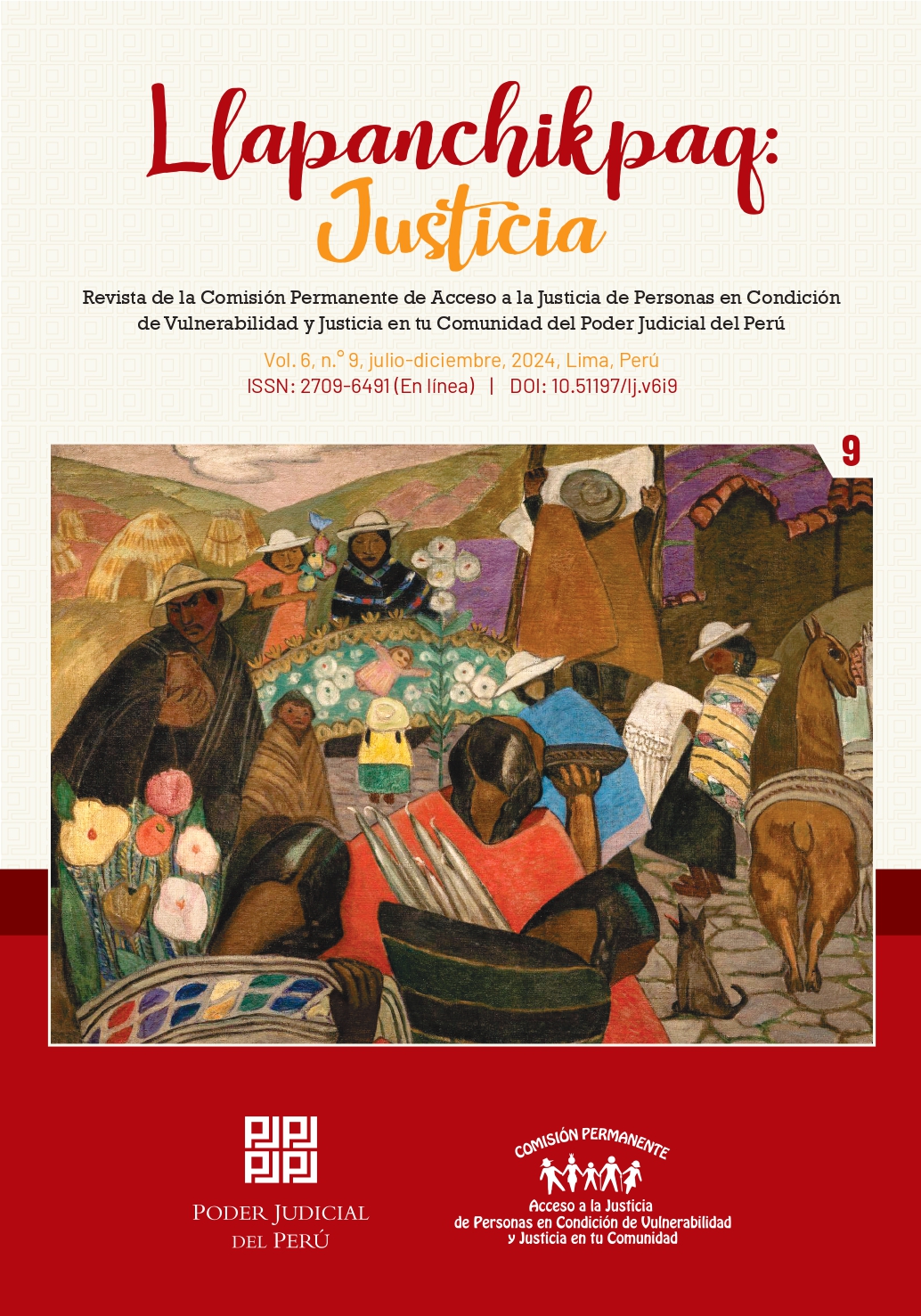Regras de Brasília para jovens presos: aplicação das Regras de Brasília através da responsabilidade criminal restrita a jovens reclusos em presídios peruanos
Resumo
O objetivo deste artigo é analisar a aplicação das Normas de Brasília através da responsabilidade criminal restrita a jovens entre dezoito e vinte e um anos. De forma que pudesse contribuir para reduzir o excesso de população nos cárceres peruanos e garantirlhes os direitos humanos. Para tanto será apresentado o desenvolvimento teórico sobre as Normas de Brasília, responsabilidade criminal restrita; estatísticas elaboradas pelo Instituto Nacional Penitenciário sobre a população criminosa e a julgamento elaborada pelo Tribunal Constitucional do Peru sobre o excesso de população nas prisões peruanas. Isso ajuda a compreender a importância da aplicação das Regras de Brasília para erradicar as condições vulneráveis dos jovens nas prisões peruanas. Que, através do uso de uma ferramenta legal como a restrição da responsabilidade criminal e algumas mudanças nas regras, ajudem a reduzir o excesso de população nas prisões peruanas em harmonia comos direitos humanos das pessoas privadas de sua liberdade.Downloads
Metrics
Referências
Acceso a la Justicia y las 100 Reglas de Brasilia (2016) [Video conferencia]. En Aula Virtual del Poder Judicial. https://youtu.be/e8NEqX3qdBo?si=_3YhXQqKH3BeZP_D
Acuerdo Plenario n.o 42016/CIJ116. Diario Oficial El Peruano (2016). https://img.lpderecho.pe/wpcontent/uploads/2021/05/AcuerdoPlenario42016CIJ116LP.pdf
Arias, D. (2012). Proporcionalidad, pena y principio de legalidad. Revista de Derecho. (38), 142 171. ISSN 01218697. https://hdl.handle.net/10495/3143
BramontArias, L. (1998). Manual de Derecho Penal. Parte General. Editorial Santa Rosa.
Carnevali, R. (2008). Derecho Penal como última ratio. Hacia una política criminal racional. Revista Ius et Praxis, 14(1), 1348. ISSN 07180012. http://dx.doi.org/10.4067/s071800122008000100002
Casación n.o 1057Cusco (2017). Corte Suprema de Justicia de la República, Sala Penal Permanente. https://static.legis.pe/wpcontent/uploads/2018/11/Casación10572017CuscoLegis.pe_.pdf
Casación n.o 1672Puno (2017). Corte Suprema de Justicia de la República, Sala Penal Permanente. https://static.legis.pe/wpcontent/uploads/2018/10/Casacion16722017PunoLegis.pe_.pdf
Casación n.o 214El Santa (2018). Corte Suprema de Justicia de la República, Sala Penal Permanente. https://www.pj.gob.pe/wps/wcm/connect/5b65bb80484922ba95a99da38f54faeb/CSSPPRC2142018ELSANTA.pdf?MOD=AJPERES& CACHEID=5b65bb80484922ba95a99da38f54faeb
Constitución Política del Perú. (1993). Sistema Peruano de Información Jurídica. https://www.web.onpe.gob.pe/modElecciones/elecciones/MarcoLegal/constitucionpoliticaperu1993.pdf
Consulta n.o 13848 Huara (2016). Corte Suprema de Justicia de la República, Sala de Derecho Constitucional y Social Permanente.
Decreto Legislativo n.o 635 (2019). Código Penal Peruano. Jurista editores.
Expediente n.o 54362014PHC/TC (2020). Tribunal Constitucional (26 de mayo de 2020).
Ferrajoli, L. (2016). Jurisdicción y Ejecución Penal. La cárcel: una contradicción institucional. Revista Crítica Penal y Poder, (11), Observatorio del Sistema Penal y los Derechos Humanos: Universidad de Barcelona. https://revistes.ub.edu/index.php/CriticaPenalPoder/article/view/16783
García Ramírez, S. (2007). Ruth Villanueva: Los menores infractores en México. Boletín Mexicano de Derecho Comparado, 1(119). https://doi.org/10.22201/iij.24484873e.2007.119.3927
Informe de Adjuntía n.o 0062018DP/ADHDP. Retos del Sistema Penitenciario Peruano: un diagnóstico de la realidad carcelaria de mujeres y varones. Defensoría del Pueblo. https://www.defensoria.gob.pe/wpcontent/uploads/2019/04/Retosdelsistemapenitenciario.pdf
Informe Estadístico Enero 2023. Instituto Nacional Penitenciario. https://siep.inpe.gob.pe/Archivos/2023/Informes%20estadisticos/informe_estadistico_enero_2023.pdf
Informe sobre derechos humanos de las personas privadas de libertad en las Américas. (31 diciembre 2011). Comisión Interamericana de Derechos Humanos. Doc. 64. https://www.oas.org/es/cidh/ppl/docs/pdf/ppl2011esp.pdf
Jiménez, J. (2016). Manual de Derecho Penal Informático. Jurista editores.
Organización Mundial de la Salud (2019). Salud del adolescente. https://www.who.int/es/healthtopics/adolescenthealth
Reglas Mínimas de las Naciones Unidas para el Tratamiento de Reclusos (Reglas de Nelson Mandela) (17 de diciembre de 2015). https://www.unodc.org/documents/justiceandprisonreform/Nelson_Mandela_RulesSebook.pdf
Resolución Administrativa n.o 2662010CEPJ. (2010). (26 de julio de 2010).
Resolución Administrativa n.o 0282016CEPJ. (2016). (3 de febrero de 2016).
Resolución Administrativa n.o 1982020CEPJ. (2020). (30 de julio de 2020).
Roxin, C. (1997). Derecho Penal, Parte General Tomo I. Fundamentos, la estructura de la teoría del delito. Civitas.
Sentencia Plena Casatoria n.o 012018/CIJ433 (2018). Corte Suprema de Justicia de la República (18 de diciembre de 2018). Solano, F. y Mejía, D. (2021). La responsabilidad restringida por edad en la determinación de la pena en el proceso inmediato en el distrito judicial de Junín 2020. https://renati.sunedu.gob.pe/handle/sunedu/3616229?locale=es
Vázquez, D. & Ortiz, H. (2020). Impunity and Economic and Social Rights. Human Rights Review, 21(2), 159180. https://doi.org/10.1007/s12142020005803
Villavicencio, F. (2014). Derecho Penal. Parte General. Jurídica Grijley E. I. R. L.
XIV Cumbre Judicial Iberoamericana. Reglas de Brasilia sobre el Acceso a la Justicia de las Personas en Condición de Vulnerabilidad (4 al 6 de marzo de 2008). Brasilia.
XIX Cumbre Judicial Iberoamericana. Reglas de Brasilia sobre el Acceso a la Justicia de las Personas en Condición de Vulnerabilidad (18 al 20 de abril de 2018). San Francisco de Quito.
Copyright (c) 2024 Luis Alberto Ramirez Tipacti

This work is licensed under a Creative Commons Attribution 4.0 International License.
Os autores mantêm seus direitos autorais e se registram sob a licença Creative Commons Attribution 4.0 International License (CC BY 4.0), que permite o uso do material publicado (adaptar - remixar, transformar e construir sobre - e compartilhar - copiar e redistribuir - o material em qualquer meio ou formato).
a. A revista permite que os autores mantenham os direitos de autor dos artigos submetidos sem quaisquer restrições.
b. Os autores mantêm o direito de partilhar, distribuir, copiar, executar e comunicar publicamente o artigo publicado na Llapanchipaq Justicia (por exemplo, colocá-lo num repositório institucional).
c. Os autores conservam o direito de publicar posteriormente o seu trabalho, de utilizar o artigo ou qualquer parte do mesmo (por exemplo, uma compilação do seu trabalho, notas para conferências, teses ou para um livro), desde que indiquem a fonte de publicação (autores do trabalho, revista, volume, número e data).
















